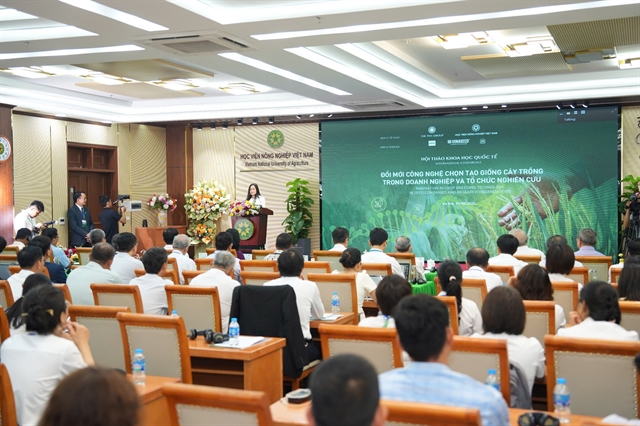According to the Việt Nam Seed Association, the planting sector has earned outstanding achievements over the years, with export turnover of agricultural products of US$62.5 billion and rice reaching nine tonnes.

HÀ NỘI – Crop breeding technology is the starting point of every value chain amid a rapidly changing climate, higher market demands and increasingly demanding consumers, an international scientific conference about crop breeding innovation heard on May 9 in Hà Nội.
Professor Dr Phạm Văn Cường, vice director of the Việt Nam Academy of Agriculture, spoke on the topic to representatives from various companies and research organisations at the conference, adding that Việt Nam and other countries have achieved great things in the innovation of plant breeding technology.
"In Việt Nam, rice varieties have been improved from requiring 180–200 days to just 100–120 days to ripen; plant height has been reduced from 180cm to 100cm; the number of panicles per plant has increased from three or four to nine or ten; yield has improved from three to four tonnes to nine to 10 tonnes per hectare. Varieties have also been developed not only for high productivity, but also for better quality and pest resistance,” Cường said.
“These are significant achievements in crop breeding," he told the conference, which was co-organised by the Việt Nam Academy of Agriculture and the PAN Group.
According to the Vietnam Seed Association, the planting sector has earned outstanding achievements over the years, with export turnover of agricultural products of US$62.5 billion and rice export turnover reaching nine tonnes.
As of last year, over 1,000 crop breeds were recognised, including 455 breeds of rice and 206 of corn, as well as several breeds of fruit, industrial trees, vegetables and flowers.
Technological innovation in crop breeding plays an important role in increasing productivity, ensuring food security and developing high-quality plant varieties that are resistant to climate change.
However, challenges in breeding include the imbalance in research between food crops and fruit trees, limitations in improving forestry product varieties and a seed production system that is still fragmented and small scale. The rate of standard crop varieties in production also remains low, especially in the Mekong Delta region.
At the conference, experts, scientists and managers discussed the current status of research and development of rice, maize, vegetables and other crops in Việt Nam.
Participants also shared experiences in using genetic resources and exploring new technological trends, such as gene editing, mutation technology, fast breeding technology and the application of artificial intelligence in crop breeding, as well as the potential for application and cooperation with domestic and international organisations and businesses.
The conference was also a venue for promoting collaboration and creating favourable conditions for exchanging genetic resources and new technologies between research institutions and enterprises, as well as cooperation in transferring new crop varieties.
Former Minister of Agriculture and Rural Development Cao Đức Phát said that Việt Nam’s agriculture and crop seed sector are facing two major challenges. The first is the need to rapidly improve income and living standards for farmers to maintain the attractiveness of agriculture and ensure farmers’ commitment amid increasing industrialisation and urbanisation. The second challenge is to develop agriculture more sustainably and quickly adapt to climate change, including by reducing greenhouse gas emissions.
The main solution to overcome these challenges are to reform policies towards a market-oriented approach and accelerate the adoption of new technologies to enhance the sector’s scientific and technological capacity. Among these solutions, innovation in crop breeding is considered a top priority, Phát said.- VNS





